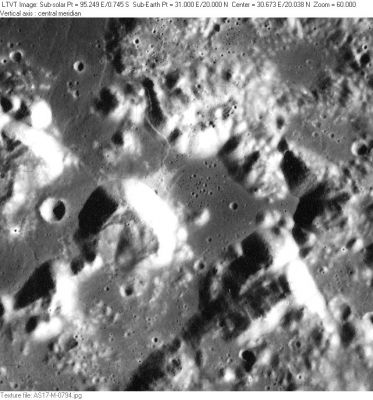Taurus-Littrow Valley
Contents
Taurus-Littrow Valley (Apollo 17 site formation name)
|
Lat: 20.0°N, Long: 31.0°E, Diam: 30 km, Depth: km, Rükl: 25 |
AS17-M-0794 Taurus-Littrow Valley is the mare area in the center of the frame.
Images
LPOD Photo Gallery Lunar Orbiter Images Apollo Images
- There are four "forgotten" Hasselblads of the Taurus-Littrow valley, photographed one orbit before the landing of Apollo 17's LM Challenger: AS17-147-22464, 22465, 22466, and 22467. The last one of those four (AS17-147-22467) was included on pages 292-293 of the splendid article Exploring Taurus-Littrow by Harrison H. Schmitt. Research: - DannyCaes Nov 28, 2007
- Hubble Space Telescope image of Taurus-Littrow Valley
Maps
(LAC zone 43D4) LAC map Geologic map LTO map Topophotomap 43D1/S1
Description
Description: Wikipedia
Additional Information
Nomenclature
- Astronaut-named feature, Apollo 17 site.
- The Landing Site Name "Taurus-Littrow Valley" is also plotted on Site Traverses chart 43D1S2.
- The largest one of the small craterlets on the floor of the Taurus-Littrow Valley was unofficially called MOCR, this during the mission of Apollo 17 in december 1972 (MOCR was NASA's abbreviation for Mission Operations Control Room). Perhaps it's possible to observe that craterlet through powerful telescopes. As seen from Apollo 17's Stations 6, 7, and 8 on the slopes of the North Massif and the Sculptured Hills, the MOCR crater should have been visible in front of the East Massif (the northern part of Mons Vitruvius). It's interesting to try to detect this crater on the surface photographs of the East Massif (made from Stations 6, 7, 8). Unfortunately, these photographs were made during EVA-3, when the sun was already too high in the sky (illuminating the whole of the MOCR crater's inner slopes, thus: no shadows).- DannyCaes Feb 24, 2013
- Eastern pass: an unofficial name for the pass between the Sculptured Hills and the East Massif (the northern part of Mons Vitruvius). The Eastern pass was frequently photographed during the mission of Apollo 17. Unfortunately, the sun's low altitude during the first part of Apollo 17's surface excursions prevented a good view of the mountains to the east of the Eastern Pass.- DannyCaes Feb 24, 2013
LPOD Articles
Bibliography
- Reed, V. S. & E. W. Wolfe (1975) Origin of the Taurus-Littrow massifs. Proc. Lunar Planet. Sci. Conf. 6th, pp. 2443-2461.
- Schmitt, Harrison H. Exploring Taurus-Littrow, National Geographic, September 1973.
